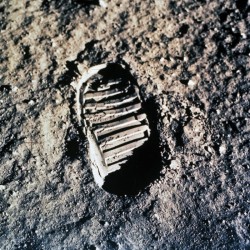 View larger
View larger
Future Moon: The Footsteps of Explorers
New activity
Learners model how impacts throughout the Moon's history have broken rocks down into a mixture of dust, rocks, and boulders that cover the lunar surface.
Open Activity
-
Rating
-
Participants Enjoyed the ActivityParticipants Learned from This ActivityActivity Instructions Were Clear and Easy to FollowWould Recommend
Related Programming Resources
Reviews
Graham Crackers? Delicious & Dangerously Distracting
Anything which involves the act of pulverizing graham crackers is bound to be a hit with kids! The downside is that they will be thinking of food the entire time, and will want to break for snacks the moment they’re finished with the pulverizing. Be prepared! And be prepared, most importantly, to hold back or purchase additional graham crackers for those snacks, as the entire point of this project is to render the ones you smash to bits into an inedible, powdery regolith simulant.
That said, with a little bit of tailoring a little attention to your audience, this activity is a *lot* of fun to execute. Older participants, including teens, will make full use of the ancillary materials linked from the project instructions, including the “Marvel Moon” comic book and “Future Moon” comic panel printables. As these printables are used in multiple activities in the STAR_net Activity Clearinghouse (not to mention the Lunar and Planetary Institute’s Public Engagement website and the NASA Wavelength resources list), it might be worth pairing this activity with one or two of those others, or hosting a series of programs all centering on “Marvel Moon” and “Future Moon.” Our younger participants lost interest in these ancillary activities, mostly because they’d seen them before and because we were executing
“Future Moon: The Footsteps of Explorers” as an embedded activity in our larger Makerspace program, where energy is high and sitting still to listen to a presentation is … limited.
The basic program goes like this:
1. Put newspapers or a tarp down on the floor.
2. Grab a rock. A large rock, but one that small hands can loft. Wrap it in foil.
3. Find a box (like an empty photocopy paper box). Put it on your tarp and fill it with layered graham crackers. Two layers, which is the recommendation within the activity, is a *minimum.* If you want really good smashing, I’d opt for four.
4. Drop the rock from varying heights, and have the participating kids observe how height changes the impact effects.
Of course, the kids will want to throw the rock, not drop it. Explaining how the additional momentum and vector affects the science is crucial, but be aware that it’s a hard thing to resist, throwing. It may prompt unwanted memories of high school track & field events, specifically learning how to correctly “throw” a shotput.
My final recommendation would be to make use of the Children’s Guide document which you can access via the link provided in the activity description. It’s simple, it’s concise, and it works in even an uncontrolled environment, so long as you feel comfortable transforming the “What to Ask…” sections into casual conversation as the kids continue crushing those crackers. I would, however, move the graham cracker part of the activity to the end, for the aforementioned reason that the kids will immediately want a snack and several of the other parts of this activity require clean hands and fairly focused attention.



